|
On a Wing and a Pot
by Bob
Brooke
While there are quite
a few museums with pottery collections throughout the world, there
are very few dedicated to pottery in general. Those having only
pottery collections usually display pottery from a particular
company, often in its former headquarters. But one museum tries to
hit all the bases. Those who happen to be in the neighborhood of Red
Wing, Minnesota, are in for a special treat at the Pottery Museum of
Red Wing.

Red Wing sits among west of the Mississippi River just above Lake Pepin,
the Dakotah spent their summers hunting and fishing. The town got its
name from Red Wing, one of the greatest chiefs of the Dakotah Nation.
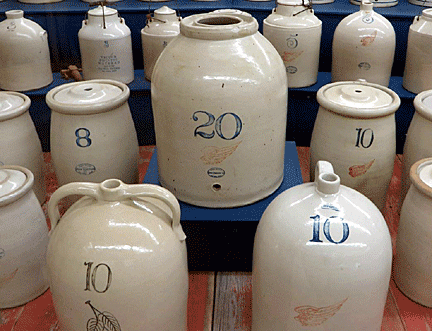 The
land around Red Wing was rich with clay. In 1861 a German immigrant
named John Paul discovered a rich pocket of clay on the land that he
intended to farm. A potter by trade, he used this clay to make the first
Red Wing stoneware. The
land around Red Wing was rich with clay. In 1861 a German immigrant
named John Paul discovered a rich pocket of clay on the land that he
intended to farm. A potter by trade, he used this clay to make the first
Red Wing stoneware.
After Paul came Philleo
Pottery, established in the heart of Red Wing in 1868, followed by
Hallem Pottery. Both went out of business – the former destroyed by
fire, the latter by the drastic price cutting of established eastern
competitors. It was in 1877 that the Red Wing Stoneware Company,
forerunner of today’s famous Red Wing Stoneware and Pottery was
established.
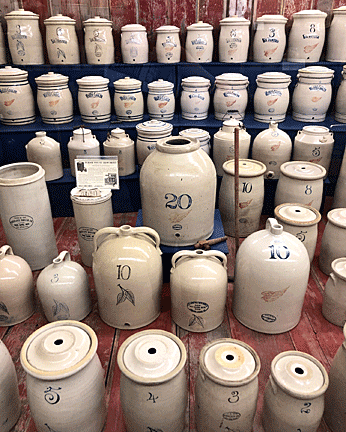 The
company supplied farmers with stoneware crocks and jugs for food and
beverage storage. As our young country grew and the Industrial
Revolution took people off the farms and brought them together in towns
and cities, health concerns prompted the development of sewer systems.
The Red Wing Sewer Pipe Company met the great need for ceramic sewer
pipes. Two other companies were formed just before the turn of the
century, Northstar Stoneware and Minnesota Stoneware. By 1906 one
company had gone out of business and the other three companies combined
as the Red Wing Union Stoneware Company. The
company supplied farmers with stoneware crocks and jugs for food and
beverage storage. As our young country grew and the Industrial
Revolution took people off the farms and brought them together in towns
and cities, health concerns prompted the development of sewer systems.
The Red Wing Sewer Pipe Company met the great need for ceramic sewer
pipes. Two other companies were formed just before the turn of the
century, Northstar Stoneware and Minnesota Stoneware. By 1906 one
company had gone out of business and the other three companies combined
as the Red Wing Union Stoneware Company.
With changing times, and
especially the invention of the refrigerator, people no longer needed
the old stoneware crocks and jugs. In 1913 the first refrigerators
were invented for home use, although the cost was out of the reach of
most people.
At this point, Red Wing Union Stoneware Company began producing flower
pots and vases, then luncheon and dinnerware, and a wide variety of art
pottery. In 1936 the name was changed to Red Wing Potteries.
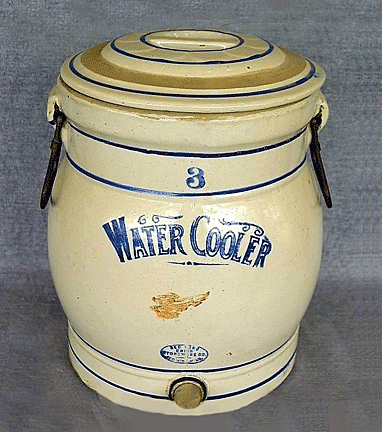 The
company added artistic hand painting to the popular solid colors in a
colorful variety of beautiful patterns and designs. Red Wing was, in
fact, the only independent pottery maker in the country that continued
this age-old art of hand painting on dinnerware, casual china and art
pottery. Their designs gave the products a creative flair, an
individualized touch that captured a unique market – quality informal
ware – which is characteristically American. Although we had been making
dishes for a long time, American potteries usually borrowed English
craftsmen and so our products were English in temperament. But in the
late 1920s a new native kind of design began to be developed and
Red Wing dinnerware developed a personality of its own in both design
and decoration. This is the informal flavor and style in which Red Wing
potteries were leaders. American homemakers loved it, with more than 100
hand decorated patterns being made, and as many as a million pieces
produced each year. The
company added artistic hand painting to the popular solid colors in a
colorful variety of beautiful patterns and designs. Red Wing was, in
fact, the only independent pottery maker in the country that continued
this age-old art of hand painting on dinnerware, casual china and art
pottery. Their designs gave the products a creative flair, an
individualized touch that captured a unique market – quality informal
ware – which is characteristically American. Although we had been making
dishes for a long time, American potteries usually borrowed English
craftsmen and so our products were English in temperament. But in the
late 1920s a new native kind of design began to be developed and
Red Wing dinnerware developed a personality of its own in both design
and decoration. This is the informal flavor and style in which Red Wing
potteries were leaders. American homemakers loved it, with more than 100
hand decorated patterns being made, and as many as a million pieces
produced each year.
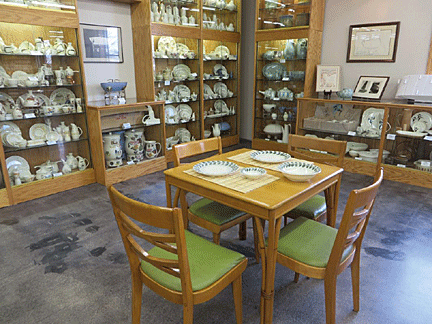
Today, dozens of displays
feature both the common and rare types of pottery produced in the Red
Wing factories, including stoneware, art pottery, and dinnerware.
Several exhibits feature artifacts used daily in the production of
various clay products. Displays of finished products demonstrate the
wide range of items produced by the Red Wing pottery industry including
hand decorated, salt glazed stoneware of the highest quality, molded
zinc stoneware, advertising ware, art pottery, and dinnerware. The
Museum also contains an important collection of memorabilia, vintage
photographs, and products related to the local clay industry to provide
for current and future educational experiences and scholarly endeavors.
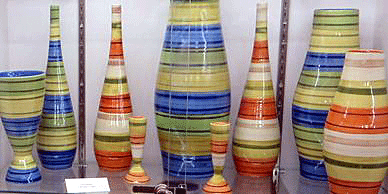
From beautiful salt
glazed folk art to durable zinc glaze stoneware, these utilitarian
pieces are displayed in a timeline that shows how they changed over time
when impacted by need and later by modern inventions, such as
refrigeration.
.gif) From
the late 1800s to the 1930s, many merchants sold their wares in Red Wing
crocks, pots, and jugs stamped with their company advertising. Numerous
examples of these advertising pieces, stamped with unique designs and
text under the glaze, are on display. From
the late 1800s to the 1930s, many merchants sold their wares in Red Wing
crocks, pots, and jugs stamped with their company advertising. Numerous
examples of these advertising pieces, stamped with unique designs and
text under the glaze, are on display.
The Pottery Museum has a treasure trove of historical photographs, many
by photographer Phil Revoir. The collection contains over 2000
photographs, depicting the history of the pottery companies and
illustrating how the ware was manufactured.
 Unique
designs and shapes glazed in a wide variety of colors are on display.
Many pieces were designed by famous artists like Belle Kogan, Eva Zeisel
and Charles Murphy. Unique
designs and shapes glazed in a wide variety of colors are on display.
Many pieces were designed by famous artists like Belle Kogan, Eva Zeisel
and Charles Murphy.
Dozens of displays highlight both the common and rare examples of
products produced in Red Wing pottery factories, including stoneware,
art pottery, and dinnerware. Several exhibits feature artifacts used
daily in the production of various clay products. Displays of finished
products demonstrate the wide range of items produced by the Red Wing
pottery industry including hand decorated, salt glazed stoneware of the
highest quality, molded zinc stoneware, advertising ware, art pottery,
and dinnerware. The Museum also contains an important collection of
memorabilia, vintage photographs, and products related to the local clay
industry to provide for current and future educational experiences and
scholarly endeavors.
<
Back to More Antiques to View
Next Article > |
